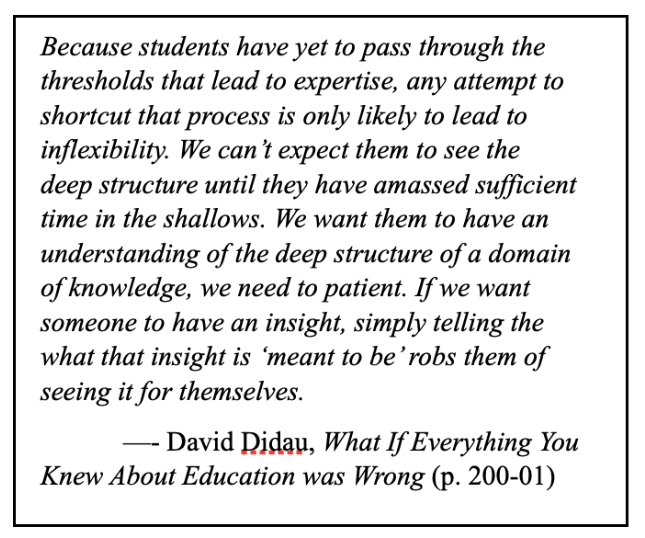Tony Jones, Mahomet, IL anthonyjones@cpm.org
Mathematics and science are two areas of academic concentration where the correct answer is a major focus for those involved. These courses seem to have the least subjectiveness of all the academic pursuits in k–12 education.
Allow me to state that I do believe we all, as educators, want to see our students be successful. We want them to achieve at a high level and demonstrate a thorough understanding of concepts and skills. Unfortunately, this focus leads us to do things that we feel maximize student performance because it is easier to discern and measure. To put it bluntly, we too often focus on the correct answer. We make increasing a student’s performance an acceptable proxy for learning. And in doing so, we can lose sight of the beauty in the dance of education in general, and in mathematics in particular.
I recently was introduced to a dichotomy that I had often experienced but never named explicitly: mimicking versus thinking. Too much of what we see in classrooms is mimicry as students memorize multiplication tables, algorithms, steps for solving problems, rules, and theorems. We ask students questions about what we have just been teaching, and then, when they hesitate, we say, “Talk to your partner,” “Look in your books,” or “Check your notes.” Other times, we simply point to clues we have written on the board or placed on the walls throughout our room. We prop up performance with prompts and then take mimicked responses as evidence of learning.
I am not advocating for a world with only wrong answers where we have no regard for the correct answers. I am, however, advocating for a world where students (and, even more so, educators) are less obsessed with being correct and much more focused on the process of understanding what it means to think through and solve problems.

Learning something new can be confusing and unsafe for many students, so students often resort to mimicry; it is a refuge. When we mimic, we find a place we can occupy where we don’t look foolish. Many students are skilled at mimicry. They are good at knowing what we want and presenting it to us in a way that looks like learning.
However, we must realize that critical thinking is THE pathway for students. Colin Sale sums it up in his book, Thinking Like a Lawyer: A Practical Framework to Teach Critical Thinking to All Students. He says, “When we don’t give our students opportunities to engage in critical thinking at all levels, we are systemically leaving brilliance on the table.”
Critical thinking is perhaps the main cog in the educational wheel for students (dare I say, it is critical!). When we choose to take the focus off the correctness, we make equity real at the classroom level; we give students the opportunity to lead, innovate, and take risks with novel ideas, which is a core part of their educational experience. We must help students see (and experience) that mistakes are a part of learning. This will never be possible in a world where students are afraid of getting the wrong answer
One caveat: I think it is important that we do not make a blanket statement that correct answers do not matter. We understand that people — administrators, parents, students — could hear that in unintended ways. But, we make it clear that if our only focus is the correctness of an answer, then we lose out on the reasoning that helps students get more sophisticated in their mathematical thinking and thus deepen their understanding.
So, how do we capitalize on the “magic of mistakes” to help students and make our classroom a place of critical thinking and mathematical reasoning? My colleagues are fans of lists, as it often helps us see things more clearly. Here are practical ideas wrapped up in a nice, concise list:
- Create a classroom where mistakes are magical.
- Anticipate “good” mistakes ahead of time and prepare responses for even the most baffling of mistakes.
- Use probing questions for those good mistakes in real-time.
- Use error analysis regularly. However, at times, do not tell them there is an error but rather allow them to see it themselves. Instead of “Who is correct?” perhaps change the question to “Who do you agree with?” or “Do you agree with any of these answers?”
- Continually ask students to explain their reasoning to help them understand the focus is on their thinking.
- Ask students to create their own “good” mistakes.
- Give a few examples of wrong answers and then ask students which of the wrong answers is more right.
What is on your list? What do you do to support the power and magic of mistakes?

